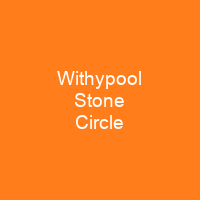Withypool Stone Circle: A Mysterious Monument on Exmoor
Imagine stepping back in time to the Late Neolithic and Early Bronze Age, around 3300-900 BCE. Wouldn’t it be fascinating to explore a place where history whispers through the ages? Withypool Stone Circle stands as one such enigmatic monument on Exmoor moorland in Somerset, England.
The Mystery of Withypool
Why were these stones arranged in this circle? Archaeologists have pondered this question for decades. Theories range from representing supernatural entities to marking territorial boundaries or even serving as astronomical observatories. But the truth remains elusive, much like the night sky above Exmoor.
The Site and Its Surroundings
Withypool Stone Circle is located on the south-western slope of Withypool Hill, measuring 36.4 meters in diameter. This circle, along with another at Porlock, are the only known prehistoric stone circles in Exmoor. The site was rediscovered in 1898 by Archibald Hamilton, who then enlisted Colonel Bramble and Harold St George Gray to survey it comprehensively.
The Stones
Only two stone circles survive in Exmoor, and Withypool is one of them. The circle features around thirty small gritstones, with the original number possibly being up to 100. These stones are about 9 inches high, 30 cm wide, and 10 cm deep. The largest protrudes about a foot from the ground, standing as silent sentinels of an ancient past.
Exmoor’s Stone Circle Legacy
Stone circles are found throughout Britain where stone is available, with a concentration in south-western Britain and north-eastern Scotland. The tradition of their construction may have lasted for 2,400 years, from 3300 to 900 BCE. These monuments on Exmoor show little evidence of human visitation immediately after creation, suggesting they were left empty as deliberate memorials.
Archaeological Insights
Do the stones represent supernatural entities or ancestors? Archaeologists suggest that the stones may symbolize supernatural entities rather than ancestors due to their association with the dead in Neolithic Britain. This theory adds another layer of mystery to these ancient structures.
The Protection and Rediscovery
The site has been designated as a scheduled monument since 1925, with legal protection under the Ancient Monuments and Archaeological Areas Act 1979. This means that Withypool Stone Circle is safeguarded for future generations to explore and ponder over.
Conclusion
Withypool Stone Circle stands as a testament to the enduring mystery of our ancient past. Just like the stars in the night sky, these stones continue to inspire us with their silent stories, inviting us to imagine what life was like thousands of years ago.

You want to know more about Withypool Stone Circle?
This page is based on the article Withypool Stone Circle published in Wikipedia (retrieved on November 29, 2024) and was automatically summarized using artificial intelligence.







